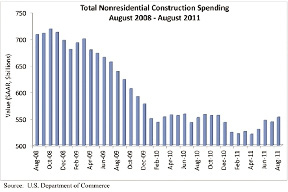In a bit of unexpected news, nonresidential construction spending, which includes both privately and publicly financed construction, was $553.1 billion in August, up 1.6% for the month and 0.1% higher from one year ago, according to the October 3 report by the U.S. Census Bureau (see graph below).
Private nonresidential construction spending inched up 0.2% in August and is 5.6% higher from one year ago. Public nonresidential construction spending was 3% higher for the month - the largest monthly increase since February 2009 - but was down 5.8% compared to the same time last year.
Meanwhile, twelve of the sixteen nonresidential construction subsectors posted increases for the month, including conservation and development, up 6.5%; public safety, 5.3% higher; sewage and waste disposal, up 4.5%; and highway and street, 3.6% higher. Five subsectors experienced growth in construction spending from August 2010: power, up 21.5%; commercial, 9.1% higher; conservation and development, up 6.5%; health care, 3.3% higher; and manufacturing, up 2.9%.
In contrast, four construction subsectors had decreases in spending for the month: lodging, down 5.6%; communication, 3.7% lower; commercial, down 2.7%; and health care-related construction, 0.3% lower. Eleven subsectors experienced reductions in construction spending over the last 12 months including lodging, 28.6% lower; religious, down 16.9%; sewage and waste disposal, down 13.2%; water supply, down 12% lower; and amusement and recreation, down 11.6%.
Residential construction spending increased 0.9% for the month, and is up 2.9% over the last twelve months. Overall, total construction spending - which includes both nonresidential and residential - rose 1.4% in August, and is up 0.9% compared to August 2010.
Analysis
"Today's release should be considered a bit of unexpected good news," said Associated Builders and Contractors chief economist Anirban Basu. "Current economic conditions pointed towards a much less rosy prediction of construction spending.
"However, many economists continue to stress the possibility of another recession, which, among other things, would have the impact of further constraining demand for construction services," Basu said.
"Over the past month, both publicly and privately financed construction spending grew - an indication that recessionary forces are being held at bay for now," said Basu. "Among the leading categories of monthly growth were conservation and development, public safety and sewage and waste disposal.
.png)








